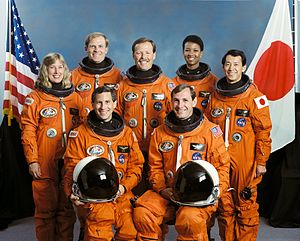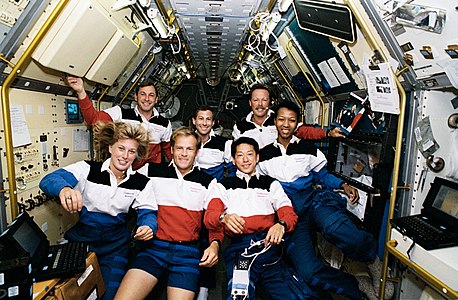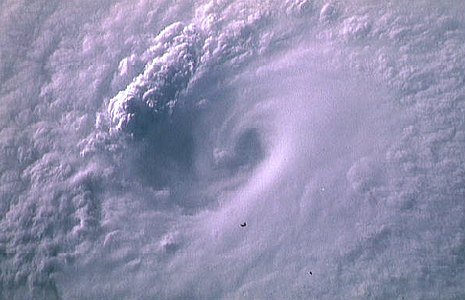STS-47
Microgravity research | |
| Operator | NASA |
|---|---|
| COSPAR ID | 1992-061A |
| SATCAT no. | 22120 |
| Mission duration | 7 days, 22 hours, 30 minutes, 24 seconds |
| Distance travelled | 5,265,523 km (3,271,844 mi) |
| Orbits completed | 126 |
| Spacecraft properties | |
| Spacecraft | Space Shuttle Endeavour |
| Launch mass | 117,335 kg (258,679 lb) |
| Landing mass | 99,450 kg (219,250 lb) |
| Payload mass | 12,485 kg (27,525 lb) |
| Crew | |
| Crew size | 7 |
| Members | |
| Start of mission | |
| Launch date | September 12, 1992, 14:23:00 UTC |
| Launch site | Kennedy Space Center, LC-39B |
| Contractor | Rockwell International |
| End of mission | |
| Landing date | September 20, 1992, 12:53:24 UTC |
| Landing site | Kennedy Space Center, SLF Runway 33 |
| Orbital parameters | |
| Reference system | Geocentric orbit |
| Regime | Low Earth orbit |
| Perigee altitude | 297 km (185 mi) |
| Apogee altitude | 310 km (190 mi) |
| Inclination | 57.02° |
| Period | 90.00 minutes |
| Instruments | |
| |
 STS-47 mission patch  Back row: Davis, Lee, Gibson, Jemison, Mohri Front row: Apt, Brown | |
STS-47 was NASA's 50th Space Shuttle mission of the program, as well as the second mission of the Space Shuttle Endeavour. The mission mainly involved conducting experiments in life and material sciences inside Spacelab-J, a collaborative laboratory inside the shuttle's payload bay sponsored by NASA and the National Space Development Agency of Japan (NASDA). This mission carried Mamoru Mohri, the first Japanese astronaut aboard the shuttle, Mae Jemison, the first African-American woman to go to space, and the only married couple to fly together on the shuttle, Mark C. Lee and Jan Davis, contrary to NASA policy.
Crew
| Position | Crew Member | |
|---|---|---|
| Commander | Fourth spaceflight | |
| Pilot | First spaceflight | |
| Mission Specialist 1 | Second spaceflight | |
| Mission Specialist 2 | Second spaceflight | |
| Mission Specialist 3 | First spaceflight | |
| Mission Specialist 4 | Only spaceflight | |
| Payload Specialist 1 | NASDA First spaceflight | |
Backup crew
| Position | Astronaut | |
|---|---|---|
| Payload Specialist 1 or 2 | NASDA First spaceflight | |
| Payload Specialist 1 or 2 | NASDA First spaceflight | |
| Payload Specialist 1 | First spaceflight | |
Crew seating arrangements
| Seat[1] | Launch | Landing |  Seats 1–4 are on the Flight Deck. Seats 5–7 are on the Middeck. |
|---|---|---|---|
| S1 | Gibson | Gibson | |
| S2 | Brown | Brown | |
| S3 | Lee | Davis | |
| S4 | Apt | Apt | |
| S5 | Davis | Lee | |
| S6 | Jemison | Jemison | |
| S7 | Mohri | Mohri |
As female and male astronauts became more prominently integrated with the shuttle program, NASA enacted an unwritten rule that husband/wife couples would not be assigned to the same mission. However, when Lee and Davis's marriage became known to NASA officials in January 1991, the officials decided to keep the assignment as is, given that both crewmembers already had important roles within the upcoming mission.[2] When asked at a NASA press conference if intimate activities would be taking place on the mission, Davis denied that possibility.[3]
Mission highlights

At the beginning of September, a problem with an oxygen line in the shuttle's main propulsion system was identified, however, it was resolved without forcing a postponement of the mission.[4]
STS-47 launched from Pad 39B at 10:23:00 a.m. EDT on September 12, 1992, and was the first on-time mission without launch delays since STS-61-B in 1985.[5]
The mission's primary payload was Spacelab-J — a joint mission between NASA and the National Space Development Agency of Japan (NASDA) — which used a crewed
Spacelab-J included 24 experiments in materials science and 20 life sciences experiments, the majority of which were sponsored by NASDA and NASA, while 2 were sponsored by collaborative civilian efforts.[8] The Payload Crew Training Manager was Homer Hickam, who also worked during the mission as a Crew Interface Coordinator to talk to the crew during their science experiments and relay any concerns from the scientists on the ground.[9]
Materials science investigations covered such fields as biotechnology, electronic materials, fluid dynamics and transport phenomena, glass and ceramics, metals and alloys, and acceleration measurements. Life sciences included experiments on human health, cell separation and biology, developmental biology, animal and human physiology and behavior, space radiation, and biological rhythms. Test subjects included the crew, Japanese koi fish (carp), cultured animal and plant cells, chicken embryos, fruit flies, fungi, plant seeds, frogs and frog eggs, and oriental hornets.[8]
Jemison and Japanese astronaut Mamoru Mohri were trained to use the Autogenic Feedback Training Exercise (AFTE),[10] a technique developed by Patricia S. Cowings that uses biofeedback and autogenic training to help patients monitor and control their physiology as a possible treatment for motion sickness, anxiety and stress-related disorders.[11][12]

Aboard the Spacelab Japan module, Jemison tested NASA's Fluid Therapy System, a set of procedures and equipment to produce
Secondary Experiments
On the middeck, a variety of experiments were conducted, including the Israel Space Agency Investigation About Hornets (ISAIAH), the Solid Surface Combustion Experiment (SSCE), and the Shuttle Amateur Radio Experiment (SAREX II).[16]: 4 External experiments using the Ultraviolet Plume Imager (UVPI) on the LACE satellite and observations at the
ISAIAH was the first microgravity experiment flown for the Israel Space Agency (ISA). Originating from
Twelve
Also on board were two experiments prepared by
While in orbit, Jemison planned to speak from orbit on a live TV conference to
The mission, scheduled to end on September 19, 1992, was extended for one more day to complete certain experiments.[22]
Gallery
-
Launch of STS-47
-
STS-47 crew pose for a portrait inside the Spacelab-J module during the mission.
-
Eye of Hurricane Bonnie (1992) photographed onboard Endeavour.
-
Alternate crew and support staff photo, featuring the seven crewmembers and spacesuit technician Sharon McDougle, front center, among others.
See also
- List of human spaceflights
- List of Space Shuttle missions
- Nikon NASA F4
- Spacelab
- Outline of space science
- Project POSTAR
- Space Shuttle
References
![]() This article incorporates public domain material from websites or documents of the
This article incorporates public domain material from websites or documents of the
- ^ "STS-47". Spacefacts. Retrieved March 4, 2014.
- ^ "Married astronauts can fly together, NASA says". United Press International. Johnson Space Center, Houston: UPI Archives. March 6, 1991. Retrieved February 8, 2022.
- ^ "Shuttle couple ready for launch in September". Tampa Bay Times. Times Publishing Company. June 13, 1992. Retrieved January 27, 2022.
At a news conference Wednesday in Huntsville, Davis answered "no" when asked if there would be sexual experiments on the seven-day mission.
- ^ "Shuttle launch set for September 12 but problem exists". Defense Daily. Vol. 172, no. 44. Access Intelligence, LLC. September 2, 1992. Retrieved July 10, 2022.
- ^ Dumoulin, Jim (June 29, 2001). "STS-47". Kennedy Space Center Science, Technology and Engineering. NASA/KSC Information Technology Directorate. Archived from the original on January 28, 2022. Retrieved January 27, 2022.
 This article incorporates text from this source, which is in the public domain.
This article incorporates text from this source, which is in the public domain.
- ^ Evans, Ben (October 28, 2012). "Of Marriage, Medaka Fish and Multiculturalism: The Legacy of STS-47". America Space. Retrieved January 27, 2022.
- ^ Fries, Colin (March 13, 2015). "Chronology of Wakeup Calls" (PDF). NASA History Division. p. 24. Archived (PDF) from the original on February 3, 2024. Retrieved February 8, 2024.
- ^ a b c NASA. Ryba, Jeanne (ed.). "STS-47". Archived from the original on May 14, 2023. Retrieved January 26, 2022.
 This article incorporates text from this source, which is in the public domain.
This article incorporates text from this source, which is in the public domain.
- ^ "'October Sky' high". Florida Today. March 29, 1999. Retrieved February 8, 2022 – via Newspapers.com.
Most of my work was with Spacelab flight, especially Spacelab J

- ^ Cowings, Patricia (Summer 2003). "NASA Contributes to Improving Health". NASA Innovation. 11 (2). Archived from the original on October 4, 2011. Retrieved September 14, 2011.
- NASA Ames Research Center. Archived from the originalon June 26, 2017. Retrieved June 3, 2019.
- ^ Bugos, Glenn E. (2014). "Atmosphere of Freedom: 75 Years at the NASA Ames Research Center" (PDF). NASA Ames Research Center. pp. 159–61. Retrieved June 3, 2019.
- S2CID 4692452.
- Dotdash. Archivedfrom the original on September 12, 2017. Retrieved September 14, 2011.
- The Titusville Herald. Archivedfrom the original on September 12, 2017. Retrieved September 11, 2017 – via Newspapers.com.
- ^ a b c d Orloff, Richard W., ed. (January 2001) [September 1992]. "Space Shuttle Mission STS-47 – Press Kit" (PDF). NASA. Archived (PDF) from the original on June 27, 2023. Retrieved February 5, 2024.
- ^ Fricke, Robert W. (October 1, 1992). STS-47 Space Shuttle Mission Report (PDF) (Report). Houston, Texas: Lockheed Engineering and Sciences Company - National Aeronautics and Space Administration. p. 22. 19930016771. Retrieved May 19, 2022.
- ^ "IAMI - Projects". IAMI. Israel Aerospace Medicine Institute. Archived from the original on December 3, 2018. Retrieved May 19, 2022.
- ISBN 9781461432784. Retrieved January 26, 2022.
- ^ "Late bloom for crystal garden". The New Scientist. January 2, 1993. Archived from the original on March 9, 2010. Retrieved September 27, 2010.
- ^ Carr, Jeffrey (September 14, 1992). "Astronaut Mae Jemison to Speak with Chicago Youth" (PDF) (Press release). Houston: NASA. p. 120. Retrieved January 27, 2022.
- ^ "1981-1999 Space Shuttle Mission Chronology" (PDF). NASA. p. 26. Retrieved January 29, 2022.





